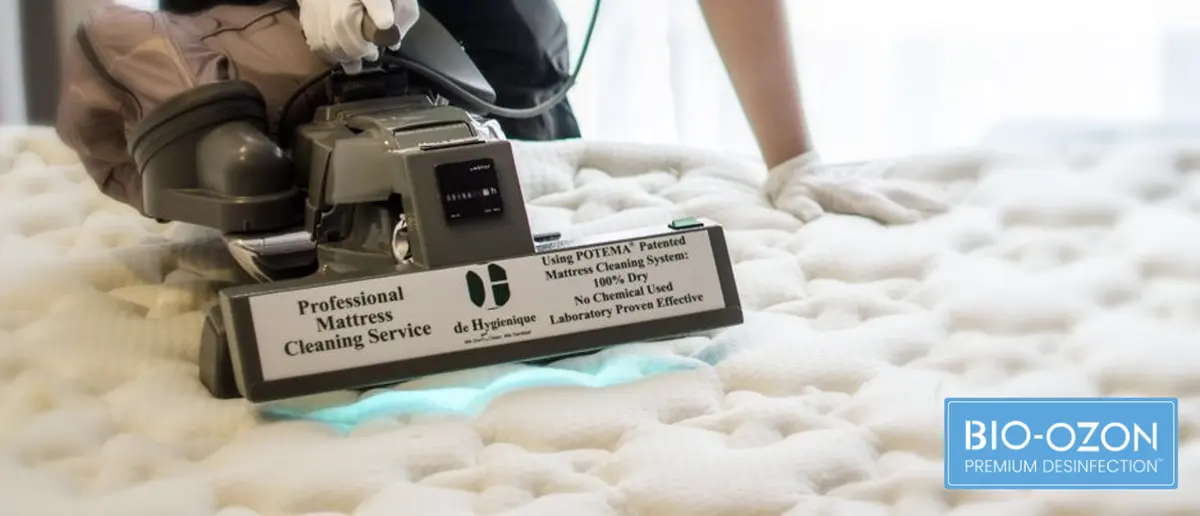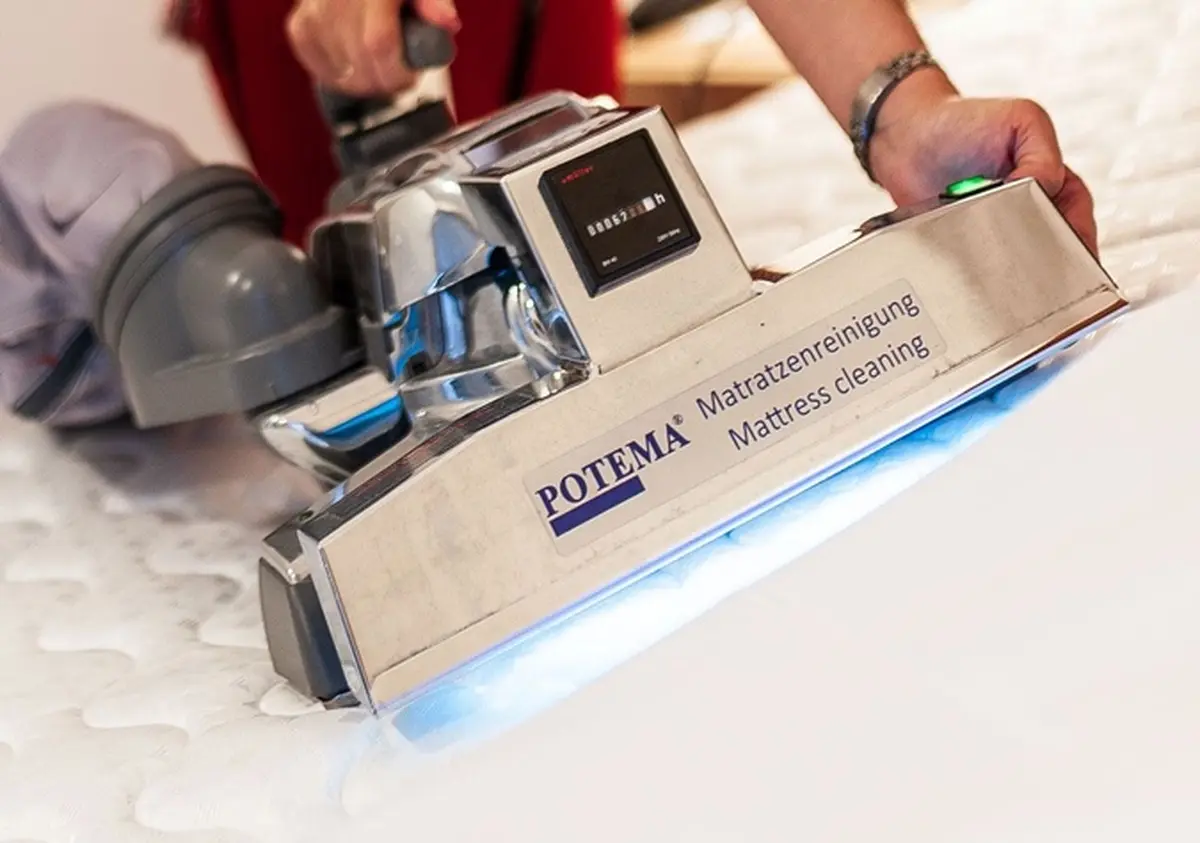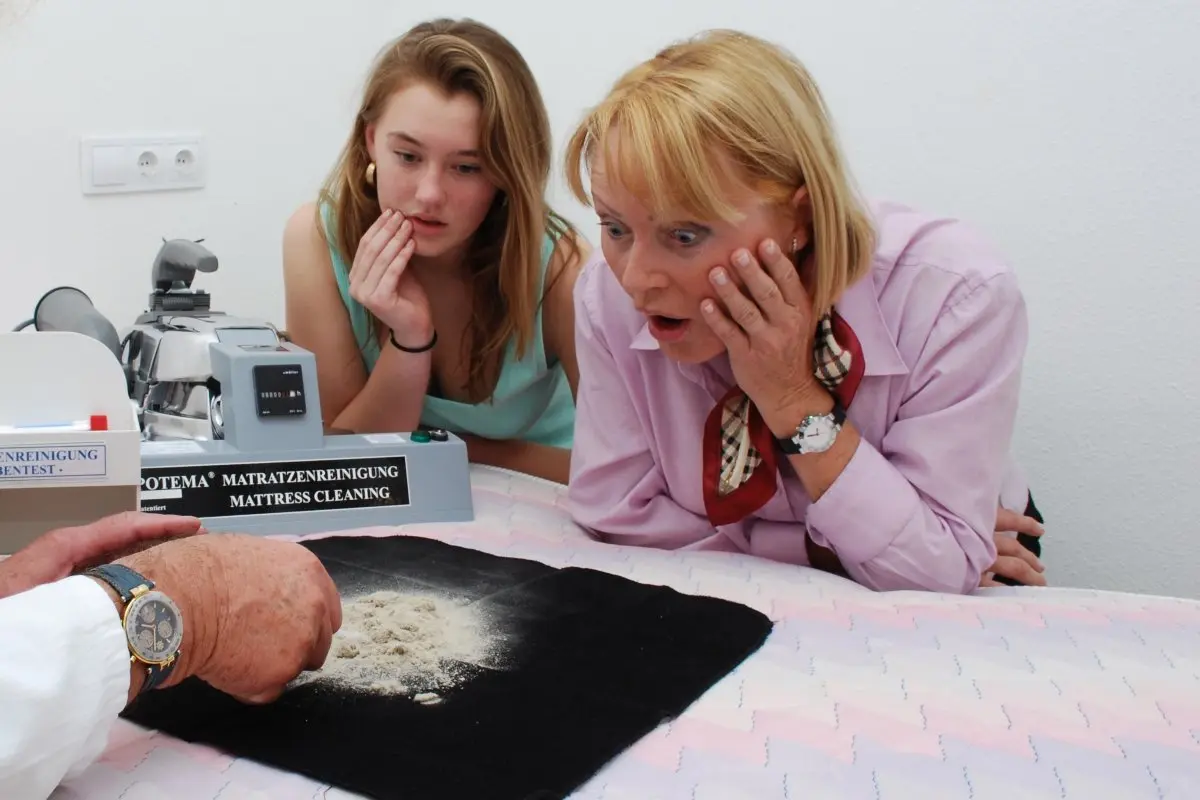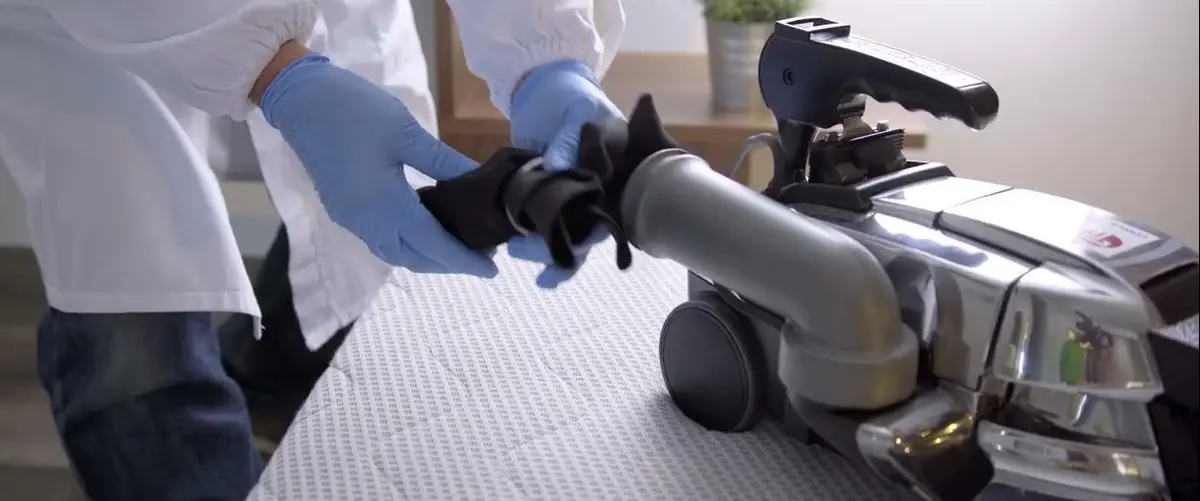Disinfection of mattresses with UV lamp
Disinfection of mattresses, disinfection of mattresses by UV lamp, disinfection of piece mattresses, disinfection of spring mattresses, disinfection of foam mattresses, disinfection of natural mattresses, disinfection of coconut mattresses, Ozone mattress cleaning and disinfection is provided by our company to clients according to their needs and desires in top quality according to our internal company standards, IICRC™ guidelines and norms and the professionally implemented POTEMA® system in our mattress and fabric cleaning facility or at your location.

The  trade mark POTEMA® defines the branded technology concept of an expertly executed Carpet Service® company dedicated to the regular maintenance, cleaning, disinfection, impregnation of synthetic, natural, wool, silk and American-made mattresses, beds and textiles. This branded concept delivers the utmost professionalism in full synergy with maintaining ethical, environmental and quality performance standards, including a contractual guarantee of contractor services.
trade mark POTEMA® defines the branded technology concept of an expertly executed Carpet Service® company dedicated to the regular maintenance, cleaning, disinfection, impregnation of synthetic, natural, wool, silk and American-made mattresses, beds and textiles. This branded concept delivers the utmost professionalism in full synergy with maintaining ethical, environmental and quality performance standards, including a contractual guarantee of contractor services.
A quality and clean mattress is the foundation for a healthy and comfortable sleep. Unfortunately, even with regular care and routine cleaning, mattresses can become home to bacteria, viruses, dust mites, mould and other microorganisms that can negatively affect our health. These invisible pollutants not only reduce the hygiene of the sleeping environment, but can also cause allergic reactions, respiratory problems or deterioration of the overall air quality in the bedroom.
Disinfecting mattresses is essential to maintaining a healthy and clean bedroom environment. Regular mattress care reduces the amount of allergens, bacteria and dust mites that can negatively affect your health and sleep quality. Whether you opt for natural methods or use modern technology such as UV light or a steam cleaner, regularity is the key to mattress longevity and hygiene.
What is UV disinfection?
UV disinfection with the POTEMA® machine, together with ozone disinfection cleaning, is the fastest and most hygienic way to deeply and thoroughly clean mattresses. The basis of the UV disinfection lamp is a fluorescent tube that generates UV-C radiation with a wavelength of 253.7 nm. This radiation disrupts cellular structures, which reliably kills viruses, bacteria, moulds and other microorganisms from the air and from directly irradiated surfaces. When disinfecting with UV-C radiation, the more powerful the radiation source, the closer the irradiated object and the longer the radiation time, the higher the disinfection efficiency.
 UV lamp helps to disinfect and sterilize all illuminated areas within the active range of the lamp. It kills bacteria, viruses, fungi and other pathogens 99% of the time. UV radiation of 185-270 nm has bactericidal effects. It damages DNA and affects all types of bacteria, only the time required to kill the type of bacteria varies. As a result of the DNA damage, further reproduction is prevented. This prevents the repair of damaged microorganisms and their subsequent multiplication. UV disinfection surface cleaning aims to prevent the spread of viruses, infections, fungi and bacteria in order to provide a sterile environment.
UV lamp helps to disinfect and sterilize all illuminated areas within the active range of the lamp. It kills bacteria, viruses, fungi and other pathogens 99% of the time. UV radiation of 185-270 nm has bactericidal effects. It damages DNA and affects all types of bacteria, only the time required to kill the type of bacteria varies. As a result of the DNA damage, further reproduction is prevented. This prevents the repair of damaged microorganisms and their subsequent multiplication. UV disinfection surface cleaning aims to prevent the spread of viruses, infections, fungi and bacteria in order to provide a sterile environment.
The UV disinfection equipment of the specialist company POTEMA® works according to our strict guidelines to ensure successful and thorough disinfection cleaning of the mattress. The POTEMA® mattress cleaning machine generates high frequency vibrations. The dirt particles inside the mattress are loosened, crushed and removed in a vacuum that is precisely adapted to the mattress. The intense UVC radiation also largely minimizes bacteria, viruses and spores. The cleaning process is harmless to materials, suitable for all mattresses and causes no noise or dust. The entire process is completely harmless to humans and the environment.
Mattress disinfection and input information
Disinfecting mattresses is an often neglected but extremely important step in maintaining household health and hygiene. Mattresses are where we spend up to a third of our lives, and their condition can significantly affect the quality of our sleep as well as our overall health. During the night, our bodies lose sweat and dead skin, which are attractants for dust mites and bacteria. If mattresses are not regularly cleaned and disinfected, they can become a source of allergies, skin irritation and other health problems.
This text takes a detailed look at the importance of disinfecting mattresses regularly, the different methods and tools you can use, and practical tips for extending the life of your mattress. The aim is to provide a comprehensive overview of all aspects of mattress disinfection and to motivate readers to make regular mattress maintenance an integral part of their lifestyle.
Why is it important to disinfect mattresses?
 Mattresses, which are not cleaned regularly, can become home to not only dust and sweat, but also dust mites, bacteria and mold. These unwanted microorganisms can cause a variety of health problems, from allergic reactions to respiratory difficulties. Here are some of the main reasons why mattress disinfection is so important:
Mattresses, which are not cleaned regularly, can become home to not only dust and sweat, but also dust mites, bacteria and mold. These unwanted microorganisms can cause a variety of health problems, from allergic reactions to respiratory difficulties. Here are some of the main reasons why mattress disinfection is so important:
- Allergy Protection: Dust mites are one of the leading causes of house dust allergies. By regularly disinfecting your mattress, you can significantly reduce the amount of dust mites.
- Improving sleep quality: Sleeping on a clean mattress improves the quality of rest and promotes respiratory health.
- Prevention of skin problems: Bacteria and other microorganisms on the mattress can cause skin irritation or even acne.
- Elimination of unpleasant odors: Sweat and dead skin can contribute to unpleasant mattress odors. Disinfection will eliminate unwanted odors.
- Extending the life of the mattress: Regular care and disinfection can extend the life of the mattress and keep it comfortable and supportive.
How often should I disinfect my mattress?
Many people ask how often a mattress needs to be disinfected. The frequency depends on several factors, such as the health of the user, the weather conditions, and whether the mattress is used daily or occasionally. It is generally recommended:
- Every 6 months: For most people, it is advisable to perform a thorough disinfection of the mattress twice a year.
- More frequent maintenance for allergy sufferers: If you have allergies or suffer from asthma, consider disinfecting every 3 months.
- In areas with higher humidity: In places with humid climates, more frequent maintenance is recommended because the humidity encourages mold growth.
However, regular mattress airing and vacuuming can be done more frequently, ideally once a month to minimize dust buildup.
How do I disinfect my mattress?
Sanitizing a mattress is not a complicated process, but it does require following a few steps. The following guide will help you clean and disinfect your mattress effectively.
Drying the mattress
The first step is to thoroughly vacuum your mattress. Use a vacuum cleaner with a HEPA filter to capture even the finest dust particles and dust mites. Focus on all parts of the mattress, especially the seams and edges where dirt can accumulate. Regular vacuuming helps remove surface dust and skin debris that can be a food source for dust mites.
Using antibacterial spray
Antibacterial sprays are ideal for eliminating bacteria on mattress surfaces. When choosing a spray, choose products that are suitable for fabrics and that do not contain harsh chemicals. Lightly spray the spray over the entire surface of the mattress and allow it to dry. This step helps to remove bacteria and prevent them from spreading.
Steam cleaner disinfection
Steam cleaners are one of the most effective tools for disinfecting mattresses. The high-temperature steam kills bacteria, dust mites, and mold. When using a steam cleaner, follow the manufacturer’s instructions and use caution so that the mattress does not get too wet. After steam disinfection, allow the mattress to dry thoroughly.
Using natural disinfectants
For those who prefer natural solutions, there are several methods you can use. Baking soda, essential oils (such as tea tree oil) and vinegar have natural antibacterial properties. Sprinkle baking soda on your mattress, leave it on for at least 30 minutes, and then vacuum. You can add a few drops of essential oil to the baking soda for added effect.
Drying the mattress
After each disinfection, the mattress must be dried thoroughly. If possible, place the mattress in the sun, as UV light helps to kill bacteria and also helps to remove moisture. If outdoor conditions are not favourable, you can use a fan or a hair dryer.
Methods and tools for disinfecting mattresses
 There are several methods and tools you can use to disinfect mattresses. Each method has its advantages and disadvantages, and the suitability of use depends on your needs and preferences.
There are several methods and tools you can use to disinfect mattresses. Each method has its advantages and disadvantages, and the suitability of use depends on your needs and preferences.
Steam disinfection
Steam cleaners are ideal for deep disinfection of mattresses. They have the advantage of not needing chemicals, but use high temperature to kill bacteria, mites and mould. However, steam cleaners are not suitable for all types of mattresses, such as those with foam cores, which can become damaged with moisture.
Antibacterial sprays and cleaners
Antibacterial sprays and cleaners are readily available and easy to use. Their application is quick, but they do not have the ability to penetrate deep into the mattress. However, they are sufficient for surface disinfection.
UV light
UV light is another effective method that kills bacteria and mites. Special UV lamps can be used on the mattress without the risk of moisture. The disadvantage is that UV lamps are not widely available and their use requires certain precautions.
How to prevent mattress contamination
Regular maintenance and prevention are key to keeping your mattress clean. The following tips will help minimize the accumulation of dust, bacteria and other contaminants on your mattress.
- Use a protective mattress cover: The cover protects the mattress from sweat, dirt and spilled liquids. It is easily washable, making it easy to maintain regularly.
- Ventilate the mattress regularly: The mattress needs air to stay fresh. It is recommended to air out the mattress weekly, which helps eliminate moisture and bacteria.
- Regular mattress rotation: Many mattresses allow for rotation, which helps even wear and reduces dust accumulation.
- Regulate room humidity: Low humidity prevents the growth of mold and bacteria. Using a dehumidifier can be beneficial in rooms where humidity is higher.
How does disinfecting mattresses contribute to a healthy environment?
Disinfecting mattresses has a positive effect not only on personal health but also on the environment. In this day and age when allergies and respiratory illnesses are on the rise, maintaining a clean environment is an important step in preventing these problems.
- Reducing allergic reactions: Removing allergens from the mattress helps reduce the incidence of allergies and asthma.
- Improving indoor air quality: A clean mattress means less dust and dust mites in the air, which improves air quality.
- Environmentally friendly disinfection methods: Using natural products like baking soda or vinegar can help you achieve cleanliness without using chemicals that can be harmful to the environment.
Allergens, mold germs, bacteria, viruses and dust mites are not only a hygiene issue in mattresses, but also a health issue. But with proper prevention, maintenance and the right choice of mattress, the risks can be significantly reduced. Even the thickest sheets and blankets cannot protect us from micro-particles. Dust mites or moulds, which often number up to one million and produce allergy-causing faeces that settle in our mouths, noses, eyes, etc. every time we move. In addition to the allergy manifesting as itching, mucous membrane inflammation, bronchitis, asthma and shortness of breath can be added. This condition can be prevented by professional cleaning and deep dry disinfection thanks to UV-C radiation or vacuum ozonation of the mattress with thorough machine vacuuming and above all regular maintenance.
Download
Technical sheet POTEMA® (PDF)
Technical sheet VIROBAG® (PDF)